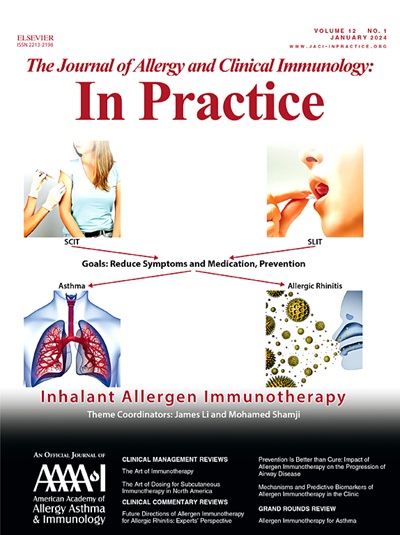Phenotypic Characteristics of Occupational Asthma Caused by Persulfate Salts in Hairdressers: A Multicenter Cohort Study
IF 8.2
1区 医学
Q1 ALLERGY
Journal of Allergy and Clinical Immunology-In Practice
Pub Date : 2025-06-01
DOI:10.1016/j.jaip.2025.03.015
引用次数: 0
Abstract
Background
The clinical and inflammatory characteristics of occupational asthma (OA) caused by persulfate salts (PS) in hair bleaches have not yet been comprehensively characterized.
Objective
This study aimed to compare the phenotypic characteristics of PS-induced OA with those of OA due to other low-molecular-weight (LMW) agents.
Methods
This study was conducted in a retrospective multicenter cohort of subjects with OA ascertained by a positive specific inhalation challenge (SIC). The clinical and inflammatory characteristics of hairdressers with PS-induced OA (n = 107) were compared with those of subjects who showed a positive SIC to isocyanates (n = 128) or various other LMW agents (n = 164).
Results
Subjects with PS-induced OA had a longer duration of exposure to the offending agent before the onset of asthma than those with OA caused the other LMW agents. They reported more frequently work-related rhinitis (76%) and showed a lower post-SIC level of fractional exhaled nitric oxide (median, 18 ppb [25th-75th percentile, 13–26]) compared with OA caused by both isocyanates (36%, P < .001 and 35 ppb [21–80], P < .001, respectively) and the other LMW agents (53%, P < .001 and 27 ppb [14–52], P < .001). Subjects with PS-induced OA showed the highest rate of isolated late asthmatic reactions (49%), but the difference reached statistical significance only when compared with LMW agents other than isocyanates (31%, P < .002).
Conclusions
The PS-induced OA is associated with a higher prevalence of work-related rhinitis and lower levels of fractional exhaled nitric oxide compared with OA caused by other LMW agents. These findings further indicate substantial phenotypic heterogeneity among this broad category of agents.
理发师职业性哮喘的表型特征:一项多中心队列研究。
背景:过硫酸盐(PS)致职业性哮喘(OA)的临床和炎症特征尚未得到全面的描述。目的:本研究旨在比较ps诱导的OA与其他低分子量(LMW) OA的表型特征。方法:本研究在一项回顾性多中心队列研究中进行,受试者通过特异性吸入刺激(SIC)阳性确定OA。将ps诱导OA的美发师(n=107)与异氰酸酯(n=128)或其他LMW药物(n=164) SIC阳性的美发师(n=164)的临床和炎症特征进行比较。结果:与其他LMW诱发的OA相比,ps诱发的OA在哮喘发作前暴露于发作剂的时间更长。与两种异氰酸酯引起的OA相比,他们报告了更频繁的与工作相关的鼻炎(76%),并显示出更低的sic后呼气一氧化氮(FeNO)水平(中位数,18 ppb[25 -75百分位数,13-26])。结论:与其他LMW药物引起的OA相比,ps诱导的OA与更高的与工作相关的鼻炎患病率和更低的FeNO水平有关。这些发现进一步表明,在这一大类药物之间存在显著的表型异质性。
本文章由计算机程序翻译,如有差异,请以英文原文为准。
求助全文
约1分钟内获得全文
求助全文
来源期刊

Journal of Allergy and Clinical Immunology-In Practice
ALLERGYIMMUNOLOGY-IMMUNOLOGY
CiteScore
11.10
自引率
9.60%
发文量
683
审稿时长
50 days
期刊介绍:
JACI: In Practice is an official publication of the American Academy of Allergy, Asthma & Immunology (AAAAI). It is a companion title to The Journal of Allergy and Clinical Immunology, and it aims to provide timely clinical papers, case reports, and management recommendations to clinical allergists and other physicians dealing with allergic and immunologic diseases in their practice. The mission of JACI: In Practice is to offer valid and impactful information that supports evidence-based clinical decisions in the diagnosis and management of asthma, allergies, immunologic conditions, and related diseases.
This journal publishes articles on various conditions treated by allergist-immunologists, including food allergy, respiratory disorders (such as asthma, rhinitis, nasal polyps, sinusitis, cough, ABPA, and hypersensitivity pneumonitis), drug allergy, insect sting allergy, anaphylaxis, dermatologic disorders (such as atopic dermatitis, contact dermatitis, urticaria, angioedema, and HAE), immunodeficiency, autoinflammatory syndromes, eosinophilic disorders, and mast cell disorders.
The focus of the journal is on providing cutting-edge clinical information that practitioners can use in their everyday practice or to acquire new knowledge and skills for the benefit of their patients. However, mechanistic or translational studies without immediate or near future clinical relevance, as well as animal studies, are not within the scope of the journal.
 求助内容:
求助内容: 应助结果提醒方式:
应助结果提醒方式:


